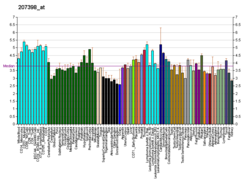Homeobox protein Hox-D13 is a protein that in humans is encoded by the HOXD13 gene.[5][6][7] This gene belongs to the homeobox family of genes. The homeobox genes encode a highly conserved family of transcription factors that play an important role in morphogenesis in all multicellular organisms.
Mammals possess four similar homeobox gene clusters, HOXA, HOXB, HOXC and HOXD, located on different chromosomes, consisting of 9–11 genes arranged in tandem. HOXD13 is the first of several HOXD genes located in a cluster on chromosome 2. Deletions that remove the entire HOXD gene cluster or the 5' end of this cluster have been associated with severe limb and genital abnormalities. The product of the mouse Hoxd13 gene plays a role in axial skeleton development and forelimb morphogenesis.[8]
Changes in the expression of the Hoxd13 gene in early lobe-finned fish may have also contributed to the evolution of the tetrapod limb.[9] Experiments investigating the impact of 5′ Hoxd overexpression in zebrafish embryos observed modified development of distal fin structures, resulting in increased proliferation, distal expansion of cartilage tissue and fin fold reduction.[10] A number of similar studies conducted with a range of animals, including catsharks[11] and marsupials,[12] lend further credibility to the role of the Hoxd13 gene in the fin-to-limb transition.
- ^ a b c GRCh38: Ensembl release 89: ENSG00000128714 – Ensembl, May 2017
- ^ a b c GRCm38: Ensembl release 89: ENSMUSG00000001819 – Ensembl, May 2017
- ^ "Human PubMed Reference:". National Center for Biotechnology Information, U.S. National Library of Medicine.
- ^ "Mouse PubMed Reference:". National Center for Biotechnology Information, U.S. National Library of Medicine.
- ^ Acampora D, D'Esposito M, Faiella A, Pannese M, Migliaccio E, Morelli F, et al. (December 1989). "The human HOX gene family". Nucleic Acids Research. 17 (24): 10385–402. doi:10.1093/nar/17.24.10385. PMC 335308. PMID 2574852.
- ^ McAlpine PJ, Shows TB (July 1990). "Nomenclature for human homeobox genes". Genomics. 7 (3): 460. doi:10.1016/0888-7543(90)90186-X. PMID 1973146.
- ^ "Entrez Gene: HOXD13 homeobox D13".
- ^ Davis AP, Capecchi MR (April 1996). "A mutational analysis of the 5' HoxD genes: dissection of genetic interactions during limb development in the mouse". Development. 122 (4): 1175–85. doi:10.1242/dev.122.4.1175. PMID 8620844.
- ^ Schneider I, Shubin NH (December 2012). "Making limbs from fins". Developmental Cell. 23 (6): 1121–2. doi:10.1016/j.devcel.2012.11.011. PMID 23237946.
- ^ Freitas R, Gómez-Marín C, Wilson JM, Casares F, Gómez-Skarmeta JL (December 2012). "Hoxd13 contribution to the evolution of vertebrate appendages". Developmental Cell. 23 (6): 1219–29. doi:10.1016/j.devcel.2012.10.015. PMID 23237954.
- ^ "Key genetic event underlying fin-to-limb evolution: Study of catsharks reveals how alterations in the expression, function of certain genes in limb buds underlie evolution of fish fins to limbs". ScienceDaily. Retrieved 2019-11-18.
- ^ Chew KY, Yu H, Pask AJ, Shaw G, Renfree MB (January 2012). "HOXA13 and HOXD13 expression during development of the syndactylous digits in the marsupial Macropus eugenii". BMC Developmental Biology. 12 (1): 2. doi:10.1186/1471-213X-12-2. PMC 3268106. PMID 22235805.





